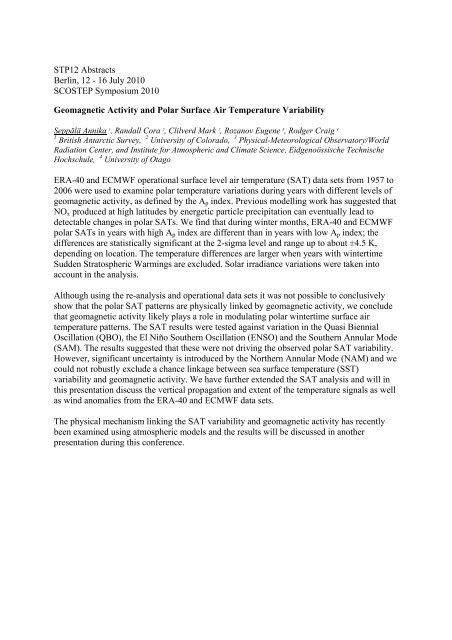scostep 2010 (stp12) - Leibniz-Institut für Atmosphärenphysik an der ...
scostep 2010 (stp12) - Leibniz-Institut für Atmosphärenphysik an der ...
scostep 2010 (stp12) - Leibniz-Institut für Atmosphärenphysik an der ...
Create successful ePaper yourself
Turn your PDF publications into a flip-book with our unique Google optimized e-Paper software.
STP12 Abstracts<br />
Berlin, 12 - 16 July <strong>2010</strong><br />
SCOSTEP Symposium <strong>2010</strong><br />
Geomagnetic Activity <strong>an</strong>d Polar Surface Air Temperature Variability<br />
Seppälä Annika 1 , R<strong>an</strong>dall Cora 2 , Clilverd Mark 1 , Roz<strong>an</strong>ov Eugene 3 , Rodger Craig 4<br />
1 British Antarctic Survey, 2 University of Colorado, 3 Physical-Meteorological Observatory/World<br />
Radiation Center, <strong>an</strong>d <strong>Institut</strong>e for Atmospheric <strong>an</strong>d Climate Science, Eidgenoössische Technische<br />
Hochschule, 4 University of Otago<br />
ERA-40 <strong>an</strong>d ECMWF operational surface level air temperature (SAT) data sets from 1957 to<br />
2006 were used to examine polar temperature variations during years with different levels of<br />
geomagnetic activity, as defined by the Ap index. Previous modelling work has suggested that<br />
NOx produced at high latitudes by energetic particle precipitation c<strong>an</strong> eventually lead to<br />
detectable ch<strong>an</strong>ges in polar SATs. We find that during winter months, ERA-40 <strong>an</strong>d ECMWF<br />
polar SATs in years with high Ap index are different th<strong>an</strong> in years with low Ap index; the<br />
differences are statistically signific<strong>an</strong>t at the 2-sigma level <strong>an</strong>d r<strong>an</strong>ge up to about ±4.5 K,<br />
depending on location. The temperature differences are larger when years with wintertime<br />
Sudden Stratospheric Warmings are excluded. Solar irradi<strong>an</strong>ce variations were taken into<br />
account in the <strong>an</strong>alysis.<br />
Although using the re-<strong>an</strong>alysis <strong>an</strong>d operational data sets it was not possible to conclusively<br />
show that the polar SAT patterns are physically linked by geomagnetic activity, we conclude<br />
that geomagnetic activity likely plays a role in modulating polar wintertime surface air<br />
temperature patterns. The SAT results were tested against variation in the Quasi Biennial<br />
Oscillation (QBO), the El Niño Southern Oscillation (ENSO) <strong>an</strong>d the Southern Annular Mode<br />
(SAM). The results suggested that these were not driving the observed polar SAT variability.<br />
However, signific<strong>an</strong>t uncertainty is introduced by the Northern Annular Mode (NAM) <strong>an</strong>d we<br />
could not robustly exclude a ch<strong>an</strong>ce linkage between sea surface temperature (SST)<br />
variability <strong>an</strong>d geomagnetic activity. We have further extended the SAT <strong>an</strong>alysis <strong>an</strong>d will in<br />
this presentation discuss the vertical propagation <strong>an</strong>d extent of the temperature signals as well<br />
as wind <strong>an</strong>omalies from the ERA-40 <strong>an</strong>d ECMWF data sets.<br />
The physical mech<strong>an</strong>ism linking the SAT variability <strong>an</strong>d geomagnetic activity has recently<br />
been examined using atmospheric models <strong>an</strong>d the results will be discussed in <strong>an</strong>other<br />
presentation during this conference.











